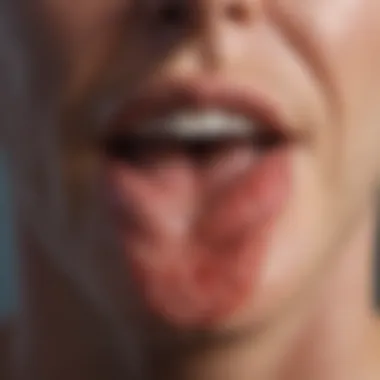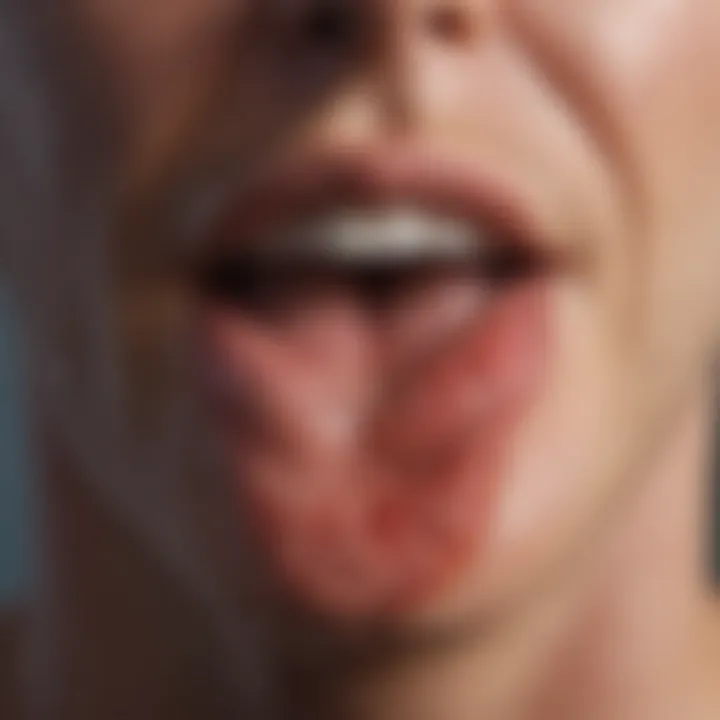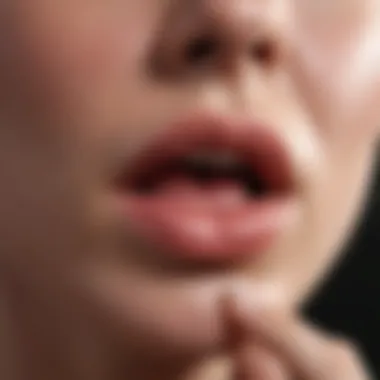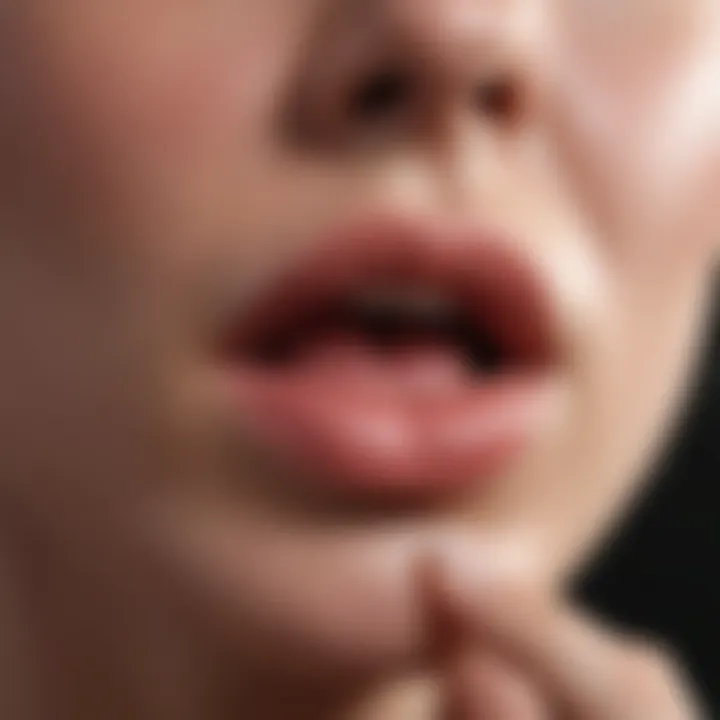Understanding Cold Sores on the Bottom Lip


Intro
Cold sores on the bottom lip are a common and often annoying condition caused by the herpes simplex virus. It is essential to understand the nuances surrounding these outbreaks since they can significantly impact both physical health and mental well-being. This article offers a detailed investigation into the causes and effects of cold sores and practical insights into treatment and preventive measures.
The herpes simplex virus primarily manifests itself as cold sores, leading to pain, discomfort, and sometimes social anxiety. Understanding how this virus operates within the body can aid individuals in managing its effects more effectively. Therefore, this guide aims to equip readers with the knowledge needed to minimize the incidence and impact of outbreaks, enabling a healthier, more confident lifestyle.
Key Benefits
Gaining a comprehensive understanding of cold sores is crucial for several reasons. Here’s how it can benefit individuals:
- Physical Health Benefits
Learning about the biological mechanisms of the herpes simplex virus can help individuals recognize symptoms early, allowing for swift intervention. Prompt treatment not only alleviates discomfort but also reduces the chances of recurrent outbreaks. Understanding triggers such as stress and dietary habits can lead to better overall health and reduced incidence of cold sores. - Mental Well-being Enhancements
Living with cold sores can impact emotional health due to stigma and visible symptoms. Knowledge empowers individuals to manage their conditions confidently, thereby enhancing self-esteem. Moreover, being informed about available treatments can alleviate the anxiety associated with outbreaks, leading to a more balanced mental state.
"Awareness is the first step in effectively managing cold sores and reducing their impact on daily life."
Understanding the Causes
Cold sores are primarily caused by the herpes simplex virus type 1 (HSV-1), though type 2 (HSV-2) can sometimes be responsible. The virus spreads through direct contact with an infected person's lesions, saliva, or even skin. Certain circumstances can escalate the likelihood of outbreaks, such as:
- Stress
Emotional or physical stress can weaken the immune system, triggering latent infections. - Illness
Other infections or illnesses can also compromise immune functions, allowing the virus to activate. - Sun Exposure
Too much sun can lead to outbreaks due to skin damage and inflammation.
Understanding these causes is critical in formulating a management strategy.
Practical Tips
Effective management of cold sores does not only lie in treatment but also in proactive steps that one can take. Here are some practical approaches to minimize outbreaks:
- Healthy Diet and Meal Planning
A balanced diet rich in vitamins, particularly vitamin C and E, can strengthen the immune system. Foods like citrus fruits, nuts, and leafy greens should be included. - Stress Management Techniques
Incorporating mindfulness practices, yoga, or meditation into your daily routine can help manage stress levels, reducing the risk of outbreaks. - Sunscreen Application
To combat sun exposure, applying lip balm with SPF before going outdoors is recommended.
By implementing these strategies, one can better manage their health and potentially lessen the frequency of cold sore occurrences.
Overview of Cold Sores
Cold sores are a common yet significant health concern. They primarily affect the bottom lip, presenting not only physical discomfort but also potential emotional distress. This section clarifies what cold sores are and why understanding them is crucial. Knowing their causes, symptoms, and treatments can enable individuals to manage outbreaks effectively.
Definition and Characteristics
Cold sores, also known as fever blisters, are small, fluid-filled blisters that typically appear on or around the lips. The herpes simplex virus (HSV), particularly HSV type 1, is the chief culprit behind these outbreaks. Remarkably, once exposed, the virus remains dormant in the body and can reactivate. Cold sores often begin with a tingling or itching sensation before blisters develop. These can rupture, oozing fluid, and eventually crust over as they heal. The duration of this cycle varies, usually lasting about one to two weeks.
Epidemiology of Cold Sores
The prevalence of cold sores is noteworthy. According to various studies, more than half of the adult population is estimated to carry the herpes simplex virus. Infection commonly occurs in childhood, often through non-sexual contact, such as sharing utensils or kissing. Once contracted, the virus is lifelong, emphasizing the importance of awareness and understanding.
Some demographics are particularly affected. Factors include age, skin type, and even geographic location. In regions with sunny climates, the risk of outbreaks may increase due to sun exposure. Understanding the epidemiology helps in recognizing how widespread this condition is and the need for effective strategies to prevent and manage cold sores.
Causes of Cold Sores
Understanding the causes of cold sores is essential. This section provides a foundational knowledge that helps readers realize the steps they can take to minimize outbreaks. Cold sores predominantly occur due to an infection with the herpes simplex virus, thus recognizing the virus's types and triggers is crucial. Identifying these causes can promote effective treatment and prevention strategies for those prone to outbreaks.
Herpes Simplex Virus Types
There are two primary types of herpes simplex virus: HSV-1 and HSV-2. While HSV-1 is typically associated with cold sores, particularly around the lips, HSV-2 more commonly causes genital herpes. However, both types can cause oral and genital infections. Recognizing the difference is important as it influences both treatment approaches and understanding of potential transmission modes. In many cases, cold sores result from HSV-1, which is highly common and can be asymptomatic. An effective approach involves awareness not only of the virus type but also how it manifests.
Triggers of Cold Sore Outbreaks
Stress and Fatigue
Stress is a significant contributor to cold sore outbreaks. When the body experiences fatigue, immune response weakens, allowing the herpes simplex virus to reactivate. Emotional stress can lead to physical symptoms, including headaches or exhaustion. The relationship between stress and cold sore outbreaks makes stress management crucial. By addressing stress through techniques such as mindfulness or regular exercise, individuals can enhance their immune system's ability to combat the virus.


Illness and Immunosuppression
Illness or having a weakened immune system can lead to an increase in cold sore outbreaks. Conditions that compromise immune function, such as HIV or cancer, make individuals more susceptible to viral reactivation. When infections occur, such as the common cold, the body’s focus on fighting illness can create an environment where the herpes virus can thrive. Therefore, maintaining overall health and managing chronic illnesses is advantageous to limit freezing outbreaks.
Exposure to Sunlight
Excessive exposure to sunlight can trigger cold sores. Ultraviolet radiation from the sun can damage skin cells, leading to reactivation of the herpes virus. This aspect is especially relevant for individuals who enjoy outdoor activities. The key characteristic is that prevention, such as using lip balms with sun protection, becomes an essential aspect of managing risks associated with cold sore outbreaks.
Other Environmental Factors
Environmental factors, including changes in temperature, climate, and humidity, also play a role in the frequency of outbreaks. For example, during winter months, dry air can cause chapped lips which may lead to cold sore sensitivity. Recognizing how these factors interact with individual vulnerabilities enhances the understanding of ongoing trends in cold sore activity. It allows for a more comprehensive preventative strategy to be employed by individuals.
"Recognizing and understanding the causes of cold sores can empower individuals to take active steps in prevention and management."
In summary, understanding the causes of cold sores entails recognizing the virus types and various triggers. This knowledge supports effective treatment, enhances preventive measures, and ultimately contributes to better management of cold sore occurrences.
Symptoms of Cold Sores
The symptoms of cold sores play a crucial role in recognizing the presence of the herpes simplex virus and initiating timely treatment. Understanding these symptoms helps individuals address their condition effectively, mitigating discomfort and potential emotional distress. Cold sores often manifest in the same way for many people, but the intensity and duration can vary. Recognizing the signs early can lead to quicker recovery and better coping strategies.
Initial Signs and Sensations
Before a cold sore fully develops, various initial signs may present themselves. Often, people experience tingling or burning sensations in the affected area, commonly identified as a prodromal phase. This period typically lasts a few hours to a day. During this time, one might also notice increased sensitivity around the lip area. Some may see slight redness or swelling, indicating that the virus is becoming active. It is essential to be aware of these signals, as they can serve as a warning for an imminent outbreak.
- Tingling or itching around the lips
- Increased sensitivity in the affected area
- Redness or slight swelling
Recognizing these early symptoms allows individuals to begin treatment with antiviral medications or topical treatments before the cold sore becomes visible.
Progression of Cold Sores
Once the cold sore has fully formed, it follows a predictable progression. Typically, a blister appears on the bottom lip, which may be painful and filled with clear fluid. This stage can last for several days. As the blister evolves, it may rupture, leaking clear or yellowish fluid, which can pose a risk to spreading the virus to others. In the subsequent healing phase, the fluid will crust over, creating a scab. This stage may take roughly one to two weeks until healing is complete, and the skin returns to its normal state.
- Blister formation on the lower lip
- Rupturing and oozing clear or yellow fluid
- Crusting over and scabbing
"Recognizing the progression of cold sores can help in managing symptoms and minimizing the chance of transmission."
Understanding the symptoms and their progression is not merely academic; it has real-world implications for effective treatment and social interactions. By being mindful of these symptoms, patients can take proactive steps to manage their condition and maintain professionalism in their daily lives.
Diagnosis of Cold Sores
The diagnosis of cold sores is a critical aspect of understanding and managing this common condition. Timely and accurate diagnosis not only helps in confirming the presence of cold sores but also facilitates appropriate treatment options. Moreover, an accurate diagnosis distinguishes cold sores from other conditions that may present with similar symptoms, such as canker sores or bacterial infections. Proper diagnosis can ultimately enhance patient outcomes and provide peace of mind.
Clinical Examination
Clinical examination is often the first step in diagnosing cold sores. During the visit, a healthcare provider will conduct a thorough assessment of the patient’s medical history as well as the presenting symptoms.
Some common characteristics that may be observed include:
- Lesion Appearance: Typically, cold sores begin as small red bumps, which then blister and may ooze. A provider will assess the appearance and location of the lesions for a definitive diagnosis.
- Symmetry: Cold sores frequently appear around the lower lip or nasal area, often in clusters. The pattern and symmetry of the outbreak can provide clues to the diagnosis.
- Duration: Noting how long the lesions have lasted is also important in determining if they are cold sores or another type of sore.
In addition, the presence of other symptoms, like fever or swollen lymph nodes, may further assist in establishing a diagnosis. This clinical approach is beneficial because it allows for immediate treatment options based on the findings.
Laboratory Testing Options
While clinical examination often suffices to diagnose cold sores, laboratory testing can be utilized for confirmation, especially in atypical cases. Tests can provide information to healthcare providers about the specific virus involved.
Common laboratory tests include:
- Polymerase Chain Reaction (PCR) Test: This test is considered the gold standard. PCR can detect the genetic materials of the herpes simplex virus quickly and accurately from a sample taken from the sore.
- Viral Culture: A swab from a blister can be cultured in a lab. Although it is less frequently done now due to the speed and accuracy of PCR, it remains an option.
- Serology Tests: Blood tests can identify antibodies for the herpes simplex virus. These are particularly useful in determining if someone has been previously infected when the lesions are not currently present.


Accurate diagnosis of cold sores is vital. It informs both treatment strategy and preventive measures, reducing the risk of future outbreaks.
In summary, the diagnosis of cold sores encompasses both clinical examination and laboratory testing methods. Each approach has its own merits, and together they form a holistic view for better understanding the condition. This understanding can empower individuals in their health journey, allowing for informed decisions regarding treatment and prevention.
Treatment Options for Cold Sores
Treatment options for cold sores are essential to understand, as they play a significant role in managing outbreaks and alleviating symptoms. The herpes simplex virus, responsible for cold sores, can be persistent and challenging to deal with. Therefore, knowing various treatment options allows individuals to make informed choices about their health.
Effective management of cold sores includes antiviral medications, topical treatments, and home remedies. Each of these has unique benefits and considerations, which will be explained in detail in the following subsections. By evaluating these options, patients can reduce the frequency and severity of future outbreaks and enhance their overall well-being.
Antiviral Medications
Antiviral medications are the cornerstone of treatment for cold sores. Drugs like acyclovir, valacyclovir, and famciclovir target the herpes simplex virus directly. These medications work by inhibiting viral replication, which shortens the duration of outbreaks and reduces the severity of symptoms.
If taken at the first signs of a cold sore, these medications can lead to quicker healing. Over time, some patients may consider suppressive therapy. This involves taking antiviral medications daily to prevent outbreaks altogether. Key points regarding antiviral medications include:
- Timing is crucial: Starting treatment at the first sign of an outbreak improves effectiveness.
- Prescription required: Most antiviral medications are available only through a healthcare provider.
- Possible side effects: Users may experience nausea, headache, or gastrointestinal issues.
Topical Treatments
Topical treatments offer targeted relief for cold sores. Products like docosanol or acyclovir cream can be applied directly to the sore. These treatments help in reducing pain and accelerating healing time. Topical treatments are generally easy to use and can provide quick relief when an outbreak occurs. Here are some points to consider:
- Application: Clean the area before applying the cream.
- Frequency: Follow package instructions for how often to apply.
- Accessibility: Many topical treatments are available over the counter, making them easy to obtain.
Topical treatments may not be as potent as oral medications but can be effective in early stages of an outbreak. They can also soothe irritated skin and provide symptomatic relief when combined with other treatments.
Home Remedies
Home remedies can complement medical treatments and provide additional relief from cold sores. Many individuals resort to these options to manage the discomfort caused by blisters. Popular home remedies include:
- Cold compress: Applying a cold, damp cloth can reduce redness and swelling.
- Aloe vera: Known for its soothing properties, aloe vera gel may promote healing.
- Lysine supplements: Some studies suggest that lysine can help decrease the frequency of outbreaks.
While home remedies may not cure cold sores, they can support skin healing and provide comfort. It is important to remember that results can vary from person to person, so individuals should find out what works best for them.
"Knowing the options available to treat cold sores can empower individuals to manage their outbreaks effectively."
In summary, when dealing with cold sores, treatment options must be assessed carefully. Antiviral medications and topical treatments provide substantial relief and prevention of severe outbreaks. Home remedies can serve as valuable adjuncts to enhance healing and comfort. By understanding these options, individuals can take proactive steps to manage their health.
Preventive Measures
Preventive measures are essential for those who frequently suffer from cold sores on the bottom lip. Effective prevention not only reduces the frequency of outbreaks but also mitigates the severity when they do occur. Understanding how to manage the triggers and implement proper hygiene can significantly enhance overall well-being. Furthermore, taking proactive steps can empower individuals, providing a sense of control over a condition that often feels unpredictable.
Reducing the Risk of Outbreaks
Reducing the risk of outbreaks is a primary focus for anyone dealing with cold sores. Key elements include:
- Awareness of Triggers: Identifying specific triggers such as stress, fatigue, and illness is beneficial. For example, individuals may find that they get outbreaks following periods of intensive work or emotional strain.
- Sun Protection: Sun exposure is a well-documented trigger for cold sore outbreaks. Using lip balms with SPF or wearing a wide-brimmed hat can help protect the bottom lip from harmful UV rays.
- Nutrition and Hydration: A balanced diet rich in vitamins, especially vitamin C and lysine, may bolster the immune system's ability to fend off the herpes simplex virus. Staying well-hydrated is also crucial, as dehydration can weaken the body’s defenses.
By implementing these strategies, individuals may notice a reduction in the frequency and intensity of outbreaks, enhancing their quality of life.
Personal Hygiene Practices
Personal hygiene plays a critical role in the prevention of cold sores. Adopting stringent hygiene practices can help limit the virus's spread and reduce reinfection risks. Important practices include:
- Regular Hand Washing: Frequent washing of hands with soap and water, especially after touching the face or lips, is essential. This practice can prevent the transfer of the virus to other areas of the body or to other individuals.
- Avoiding Close Contact: During an outbreak, individuals should take care to avoid close contact with others, particularly newborns and individuals with weakened immune systems.
- Using Personal Items: Avoid sharing items such as towels, eating utensils, and lip products. The herpes simplex virus can survive on surfaces, leading to potential transmission.
"Hygiene is not just about keeping clean; it's about understanding the implications of our habits on our health."
Implementing these personal hygiene guidelines can significantly decrease the risk of cold sore outbreaks and create a healthier environment for oneself and others.


Impact on Quality of Life
Understanding the impact of cold sores on the bottom lip is crucial for those affected, as it significantly influences daily life, personal interactions, and overall well-being. Cold sores, primarily caused by the herpes simplex virus, can induce feelings of embarrassment and self-consciousness, thus affecting one's emotional health. Many individuals with cold sores experience heightened anxiety or stress due to the visibility of the sores and the potential judgments from others. These psychological burdens can lead to avoidance of social activities, which ultimately reduces overall quality of life.
Emotional and Psychological Effects
The emotional toll of having cold sores is profound. Many individuals report feelings of shame or frustration when outbreaks occur. This dissatisfaction is often linked to the appearance of the sores, which can persist for several days, leading to a negative self-image. Even once the sores have healed, the fear of future outbreaks can create an ongoing cycle of anxiety.
Additionally, people may develop a sense of isolation. It is common for individuals to withdraw from social or professional engagements to prevent potential exposure to virus. Uncertainty and worry about how one might be perceived by colleagues or friends can further exacerbate stress and disappointment. The need to manage physical discomfort adds another layer of psychological burden, making the experience of cold sores multifaceted.
Social Implications
Socially, cold sores can create barriers to forming and maintaining relationships. People affected might feel compelled to limit their interactions for fear of transmitting the virus. This can lead to loneliness and reduce opportunities for social support, which are essential for emotional resilience. Furthermore, social stigma regarding cold sores sometimes permeates communities, leading to assumptions about one's hygiene or health practices. These misconceptions can foster misunderstandings and alter perceptions in personal relationships.
In professional settings, individuals with recurring cold sores may hesitate to engage fully in team activities or meetings. They might avoid situations involving close contact, thereby affecting teamwork and collaboration. The result can be a detrimental impact on both personal and work life, prolonging the cycle of anxiety and stress.
Cold sores can not only affect physical health but have significant emotional and social consequences that impact quality of life.
Living with Cold Sores
Living with cold sores can present unique challenges. For many individuals, the emotional and psychological weight of these outbreaks can be just as significant as the physical manifestations. Understanding this aspect is vital, as it affects not only personal well-being but also social interactions and professional life. Adopting strategies to manage cold sores effectively can minimize disruptions and enhance quality of life.
Managing Frequent Outbreaks
Frequent cold sore outbreaks can be distressing. Managing these occurrences is crucial for those affected. Here are some practical approaches:
- Antiviral medications: Regular use of antiviral medications, like Acyclovir or Valacyclovir, can reduce the frequency of outbreaks. Consulting with a healthcare provider is recommended to determine the best plan.
- Awareness of triggers: Identifying personal triggers can aid in prevention. Stress, lack of sleep, and dietary factors often play a role. Keeping a diary to track these factors may help identify patterns.
- Topical treatments: The application of topical products can alleviate symptoms if an outbreak occurs. Creams containing docosanol can speed up healing if applied at early signs.
The key is finding a tailored approach that works for each individual, as responses to treatment can vary.
Lifestyle Modifications
Adapting certain lifestyle choices can significantly influence the frequency and severity of outbreaks. Consider the following modifications:
- Healthy diet: Emphasizing a diet rich in fruits, vegetables, and whole grains supports immune function. Foods high in arginine should be moderated; these include nuts and chocolate, which may contribute to outbreaks.
- Stress management: Techniques to reduce stress are essential. Activities such as yoga, meditation, or regular exercise can enhance mental resilience and lower the chance of an outbreak.
- Sun protection: Ultraviolet rays can trigger cold sores. Applying a high-SPF lip balm before outdoor activities helps protect against sun exposure.
"Lifestyle changes, alongside medical treatment, can offer a comprehensive approach to managing cold sores effectively."
Making these adjustments can lead to a better quality of life and fewer disruptions associated with herpes simplex virus outbreaks. Emphasizing holistic well-being is productive and necessary for those living with this condition.
Future Research Directions
Exploring future research directions in the realm of cold sores is crucial for several reasons. The herpes simplex virus is a persistent challenge in the field of virology and public health. Understanding how this virus operates can lead to more effective treatments and preventative measures, therefore directly benefiting those affected by cold sores. The need for ongoing research is not merely to enhance existing knowledge but to develop innovative solutions that address the shortcomings of current approaches.
Advancements in Treatment
In recent years, there have been significant advancements in treatment options for cold sores. Traditional antiviral medications like acyclovir and valacyclovir have been mainstays in managing outbreaks. However, new therapies seek to improve efficacy and patient adherence. Research into novel antiviral compounds, such as antiviral peptides and small-molecule inhibitors, holds promise. These new treatments aim to not only shorten the duration of outbreaks but also reduce the frequency of recurrence. Additionally, clinical trials around vaccine development are gaining traction. Vaccination could potentially prevent the initial infection or mitigate the severity of outbreaks in already infected individuals, marking a substantial leap from the current management strategies.
Understanding the Virus
A deeper understanding of the herpes simplex virus, specifically its biological mechanisms, is essential for future research initiatives. This includes studying the virus's latency or dormancy in neurons, transduction pathways, and triggers for reactivation. Identifying genetic variations within the virus may also reveal why some individuals experience more frequent outbreaks than others. Enhanced knowledge can pave the way for targeted therapies that address personal genetic susceptibility to the virus. Ultimately, as researchers continue to unlock the complexities of the virus, they can contribute to prevention strategies that are more effective on an individual level, improving the long-term management of cold sores.
"Continuous research into viral mechanisms and potential treatments can fundamentally alter the approach to herpes simplex virus management."
Engaging in rigorous scientific inquiry not only addresses an immediate health concern but also lays the groundwork for innovative therapies that may transform the lives of many.
Finale
In this article, we examined the intricate relationship between cold sores on the bottom lip, their triggers, and methods for effective treatment and prevention. Cold sores, primarily caused by the herpes simplex virus, have significant implications for both physical health and emotional well-being. They are common, yet often misunderstood, leading to an array of questions regarding their management.
The importance of understanding cold sores extends beyond basic knowledge. Recognizing the causes—ranging from viral infections to environmental factors—enables individuals to adopt preventive strategies. For instance, being aware of triggers like stress, fatigue, and exposure to sunlight allows for better personal health management. Individuals can minimize the frequency of outbreaks, hence reducing discomfort.
Moreover, exploring treatment options, including antiviral medications and topical treatments, highlights the various paths to alleviate symptoms and shorten recovery times. Knowledge of home remedies stands as an essential aspect for many seeking relief without always resorting to pharmaceutical options.
Furthermore, considering the quality of life impacted by cold sores is crucial. Emotional and psychological factors weigh heavily on individuals, as they navigate social situations while dealing with visible symptoms on sensitive areas like the lip. Thus, management strategies, both medical and lifestyle modifications, become vital components of living with cold sores.















